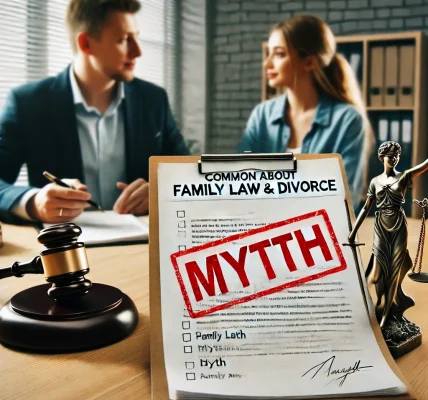Divorce is often seen as a long and emotionally draining process, but it doesn’t always have to be that way. If both spouses agree on major issues like property division, child custody, and spousal support, an uncontested divorce can be the fastest and least expensive way to legally end a marriage.
This guide will help you understand:
✔ What an uncontested divorce is and how it works
✔ The legal steps to filing for an uncontested divorce
✔ How to qualify for a fast divorce
✔ Tips to avoid delays and legal complications
By the end of this article, you’ll have a clear roadmap for securing a quick and hassle-free divorce while protecting your legal rights.
What is an Uncontested Divorce?
An uncontested divorce means that both spouses agree on all major legal and financial issues, such as:
✅ Division of assets and debts
✅ Child custody and visitation rights
✅ Child support and alimony (spousal support)
✅ Any other financial settlements
Since there are no disputes, the process is much faster compared to a contested divorce, where spouses must argue their case in court.
Benefits of an Uncontested Divorce
A fast divorce through uncontested proceedings offers multiple advantages:
💰 Lower Costs: Since there is no lengthy court battle, you save on legal fees.
🕒 Faster Processing: Without disputes, the divorce process moves quickly through the legal system.
😌 Less Stress: Avoiding court fights reduces emotional distress for both spouses and children.
🤝 More Control: You and your spouse can negotiate your own terms rather than letting a judge decide.
👶 Better for Children: Reduces the negative impact on kids by promoting a peaceful resolution.
Who Qualifies for an Uncontested Divorce?
To qualify for an uncontested divorce, you and your spouse must:
✔ Agree on all divorce terms before filing
✔ Meet your state’s residency requirements
✔ Be willing to sign all necessary documents without court intervention
Some states require a waiting period before finalizing a divorce, but an uncontested process significantly shortens the timeline.
How to Get a Fast Divorce: Step-by-Step Guide
Step 1: Check Residency Requirements
Every state has residency requirements that determine whether you can file for divorce there. Typically, you or your spouse must have lived in the state for at least 6 months to 1 year.
👉 Tip: Check your state’s divorce residency laws before filing to avoid unnecessary delays.
Step 2: Draft a Settlement Agreement
A divorce settlement agreement outlines how you and your spouse will handle:
📌 Division of property and debts
📌 Child custody and support arrangements
📌 Alimony or spousal support (if applicable)
This agreement should be written, signed, and notarized to make it legally binding.
👉 Tip: Work with a family law attorney or use an online divorce service to ensure the agreement is legally sound.
Step 3: File the Divorce Petition
To officially start the process, one spouse must file a divorce petition (also called a “complaint” in some states) in family court. This document includes:
📜 Names and addresses of both spouses
📜 Grounds for divorce (e.g., “irreconcilable differences”)
📜 A request for approval of the settlement agreement
Once filed, the court will issue a case number and schedule any required hearings.
👉 Tip: Some states allow e-filing, which speeds up the process significantly.
Step 4: Serve the Divorce Papers
The filing spouse must formally notify the other spouse by serving the divorce papers. This can be done through:
📌 Personal delivery (by a process server)
📌 Certified mail
📌 A court-appointed method (if the spouse is unavailable)
If both spouses have already signed the agreement, this step is just a formality.
👉 Tip: If your spouse is cooperative, they can sign a waiver of service to skip this step.
Step 5: Attend a Final Hearing (if required)
Many states do not require a court hearing for uncontested divorces. However, some states may require a brief hearing where a judge reviews and approves the settlement.
If a hearing is required, bring:
✅ Your divorce petition and settlement agreement
✅ Proof of residency (e.g., utility bill, driver’s license)
✅ Any financial documents (if necessary)
👉 Tip: If everything is in order, the judge will approve the divorce the same day.
Step 6: Receive Your Divorce Decree
Once the judge signs the divorce decree, your marriage is officially dissolved.
How long does it take?
⏳ Some states finalize uncontested divorces in as little as 30-60 days.
⏳ Others have waiting periods (e.g., 3-6 months) before the divorce is finalized.
👉 Tip: Check your state’s laws to see if you can expedite the process.
How to Avoid Delays in an Uncontested Divorce
Even in an uncontested divorce, small mistakes can delay the process. Here’s how to avoid common pitfalls:
❌ Incomplete Paperwork: Ensure all required forms are correctly filled out and signed.
❌ Missed Deadlines: Respond to court notices and file documents on time.
❌ Disagreements Arising Later: Confirm that both spouses fully agree before filing.
❌ Wrong Filing Location: File in the correct jurisdiction to avoid rejection.
👉 Tip: Consider using an online divorce service to streamline the paperwork.
How Much Does an Uncontested Divorce Cost?
💲 Filing Fees: $100 – $500 (varies by state)
💲 Attorney Fees (if hired): $500 – $2,500
💲 Online Divorce Services: $100 – $300
👉 Tip: Uncontested divorces are 5-10 times cheaper than contested ones.
Which Divorce Option Offers the Best Returns?
When considering a fast divorce, an uncontested divorce offers the best:
✅ Financial Savings – Lower legal costs and court fees
✅ Emotional Relief – Less stress and faster closure
✅ Time Efficiency – Divorce finalized in weeks rather than years
If both spouses mutually agree to divorce terms, an uncontested divorce is the quickest, easiest, and most cost-effective option.
Final Thoughts
Getting a fast divorce is possible with proper planning and legal knowledge. By choosing an uncontested divorce, you can avoid the stress, costs, and delays of a traditional court battle.
📢 Disclaimer: This article is for informational purposes only and does not constitute legal advice. Always consult a licensed family law attorney for personalized guidance.




